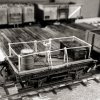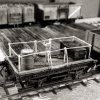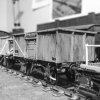Lyndhurstman
Western Thunderer
Hello Dear Reader/Insomniac,
Welcome to my virtual workbench. Please wipe your feet. Would you like a cup of tea?
You are cordially invited to:
The centre of this minimum opus (© Iain Rice - all of this is his fault really..) is the alliterative accommodation for weary wagonry that is the Watkins Wharf Wagon Works; a black hole of missing delivery dates, strong language and prize vegetables (some of whom are capable of tending allotments) that serves as hospital-cum-dumping ground, catering to the sick and weary purveyors of all manner of goods transhipped along the strained sinews of this rubble-filled corner of the post-war rail network, and most final of rites upon the sad, neglected remnants of the nationalised stock that had served so well throughout the Second World War.
Most of this waffling will take initially take the form of small pictorial representations of things that the WWWW takes on. In recent times - thanks to their 'go ahead' MD, Ernest Bay, they have been successful in acquiring a number of discarded and unrequired vans and open wagons, and - just recently - have also been selected to manufacture a small run of wagons for BR themselves (although, strangely, the majority of these come in the form of a kit that is delivered from Kircaldy in the far North, and made on site under the manufacturers instruction).
So, as I say, welcome.

Welcome to my virtual workbench. Please wipe your feet. Would you like a cup of tea?
You are cordially invited to:
- leave now with your sanity intact
- stick around and partake in the joyous expose of ignorance, ham-fistedness and crap puns that make up the sanctified remnants of my existence beyond the padded walls of my daily battles with emails, teleconferences and an seemingly increasing number of rubbish drivers I encounter on my commute into Britain's Ocean City (in truth, a dreich, car-swamped collection of villages stiched together by traffic lights and roundabouts).
The centre of this minimum opus (© Iain Rice - all of this is his fault really..) is the alliterative accommodation for weary wagonry that is the Watkins Wharf Wagon Works; a black hole of missing delivery dates, strong language and prize vegetables (some of whom are capable of tending allotments) that serves as hospital-cum-dumping ground, catering to the sick and weary purveyors of all manner of goods transhipped along the strained sinews of this rubble-filled corner of the post-war rail network, and most final of rites upon the sad, neglected remnants of the nationalised stock that had served so well throughout the Second World War.
Most of this waffling will take initially take the form of small pictorial representations of things that the WWWW takes on. In recent times - thanks to their 'go ahead' MD, Ernest Bay, they have been successful in acquiring a number of discarded and unrequired vans and open wagons, and - just recently - have also been selected to manufacture a small run of wagons for BR themselves (although, strangely, the majority of these come in the form of a kit that is delivered from Kircaldy in the far North, and made on site under the manufacturers instruction).
So, as I say, welcome.





















